Movement Control Tests For Lumbar Spine: Difference between revisions
Carin Hunter (talk | contribs) No edit summary |
Carin Hunter (talk | contribs) No edit summary |
||
| Line 2: | Line 2: | ||
== Introduction == | == Introduction == | ||
In the physiotherapy community there is a general thought that the lack of movement control is related to a poor adaptations due to a "lack of awareness" which could contribute to lower back pain. There is little evidence to support this but it is a good assessment tool, often being used as an asterisk sign. There is little difference in movement control patterns between those with lower back pain and without. Movement control tests should be considered without other larger impairments. What is not tested is how these compare to posterior chain strengthening or aerobic conditioning, both of which have been shown to improve low back pain. Further, biomedical impairments should always be graded against psychological and social “impairments”. | |||
Some patients may benefit by knowing the impairments found and others may not. This is discretionary. It depends on how much the patient needs to know why they are in pain and the purpose of your interventions. Too much information can be | Some patients may benefit by knowing the impairments found and others may not. This is discretionary. It depends on how much the patient needs to know why they are in pain and the purpose of your interventions. Too much information can be unhelpful, but insufficient information can be frustrating. Good questioning will elicit patient concerns so you know what needs to be addressed. | ||
Tests<ref>Alrwaily M, Timko M, Schneider M, Stevans J, Bise C, Hariharan K, Delitto A. [https://academic.oup.com/ptj/article/96/7/1057/2864925 Treatment-based classification system for low back pain: revision and update.] Physical therapy. 2016 Jul 1;96(7):1057-66.</ref> are considered positive if with cueing and demonstration the person can not perform correctly<ref name=":0">Lehtola V, Luomajoki H, Leinonen V, Gibbons S, Airaksinen O. [https://link.springer.com/article/10.1186/s12891-016-0986-y Sub-classification based specific movement control exercises are superior to general exercise in sub-acute low back pain when both are combined with manual therapy: A randomized controlled trial.] BMC musculoskeletal disorders. 2016 Dec;17(1):1-9.</ref>. | == Six Movement Control Tests == | ||
In the study by Luomajoki<ref name=":1" />, as patients did not know the tests, only clear movement dysfunction was rated as incorrect. If the movement control improved by instruction and correction, it was considered that it did not infer a relevant movement dysfunction. Tests<ref>Alrwaily M, Timko M, Schneider M, Stevans J, Bise C, Hariharan K, Delitto A. [https://academic.oup.com/ptj/article/96/7/1057/2864925 Treatment-based classification system for low back pain: revision and update.] Physical therapy. 2016 Jul 1;96(7):1057-66.</ref> are considered positive if with cueing and demonstration the person can not perform correctly<ref name=":0">Lehtola V, Luomajoki H, Leinonen V, Gibbons S, Airaksinen O. [https://link.springer.com/article/10.1186/s12891-016-0986-y Sub-classification based specific movement control exercises are superior to general exercise in sub-acute low back pain when both are combined with manual therapy: A randomized controlled trial.] BMC musculoskeletal disorders. 2016 Dec;17(1):1-9.</ref>. The following six movement control test were selected by Nick Rainey for the mentoring course. They come from the following articles: | |||
* Luomajoki H, Kool J, De Bruin ED, Airaksinen O. [https://bmcmusculoskeletdisord.biomedcentral.com/articles/10.1186/1471-2474-8-90 Reliability of movement control tests in the lumbar spine.] BMC musculoskeletal disorders. 2007 Dec;8(1):1-1.<ref name=":1" /> | |||
* Meier R, Emch C, Gross-Wolf C, Pfeiffer F, Meichtry A, Schmid A, Luomajoki H. [https://bmcmusculoskeletdisord.biomedcentral.com/articles/10.1186/s12891-021-04269-7 Sensorimotor and body perception assessments of nonspecific chronic low back pain: a cross-sectional study.] BMC Musculoskeletal Disorders. 2021 Dec;22(1):1-0.<ref name=":2">Meier R, Emch C, Gross-Wolf C, Pfeiffer F, Meichtry A, Schmid A, Luomajoki H. [https://bmcmusculoskeletdisord.biomedcentral.com/articles/10.1186/s12891-021-04269-7 Sensorimotor and body perception assessments of nonspecific chronic low back pain: a cross-sectional study.] BMC Musculoskeletal Disorders. 2021 Dec;22(1):1-0.</ref> | |||
===== 1. Waiter’s Bow: ===== | |||
'''Test protocol:''' Flexion of the hips in upright standing without movement (flexion) of the low back.<ref name=":1" /> | |||
'''Correct''': Forward bending of the hips 50-70° without flexion of the low back.<ref name=":1">Luomajoki H, Kool J, De Bruin ED, Airaksinen O. [https://bmcmusculoskeletdisord.biomedcentral.com/articles/10.1186/1471-2474-8-90 Reliability of movement control tests in the lumbar spine.] BMC musculoskeletal disorders. 2007 Dec;8(1):1-1.</ref> | '''Correct''': Forward bending of the hips 50-70° without flexion of the low back.<ref name=":1">Luomajoki H, Kool J, De Bruin ED, Airaksinen O. [https://bmcmusculoskeletdisord.biomedcentral.com/articles/10.1186/1471-2474-8-90 Reliability of movement control tests in the lumbar spine.] BMC musculoskeletal disorders. 2007 Dec;8(1):1-1.</ref> | ||
'''Incorrect''': Flexion occurring in the low back prior to 50° of hip flexion.<ref name=":1" /> | '''Incorrect''': Flexion occurring in the low back prior to 50° of hip flexion.<ref name=":1" /> | ||
[[File:Waiters Bow.webp|center| | [[File:Waiters Bow.webp|center|alt=|thumb|685x685px|Waiter’s Bow<ref name=":1" />]] | ||
<ref name=":1" /> | |||
===== 2. Sitting Knee Extension: ===== | ===== 2. Sitting Knee Extension: ===== | ||
'''Test protocol:''' Upright sitting with corrected lumbar lordosis; extension of the knee without movement (flexion) of low back <ref name=":1" /> | |||
'''Correct''': Upright sitting with lumbar lordosis; extension of the knee to within 50° of straight without movement of LB.<ref name=":1" /> | '''Correct''': Upright sitting with lumbar lordosis; extension of the knee to within 50° of straight without movement of LB.<ref name=":1" /> | ||
'''Incorrect''': Low back moving in flexion prior to within 50° of straight. <ref name=":1" /> | '''Incorrect''': Low back moving in flexion prior to within 50° of straight. <ref name=":1" /> | ||
[[File:Sitting Knee Extension.webp|center| | [[File:Sitting Knee Extension.webp|center|alt=|thumb|685x685px|Sitting Knee Extension<ref name=":1" />]] | ||
<ref name=":1" /> | |||
===== 3. Rocking Backwards: ===== | ===== 3. Rocking Backwards: ===== | ||
'''Test protocol:''' Transfer of the pelvis backwards ("rocking") in a quadruped position keeping low back in neutral.<ref name=":1" /> | |||
'''Correct''': 120° of hip flexion without movement of the low back by transferring pelvis backwards.<ref name=":1" /> | '''Correct''': 120° of hip flexion without movement of the low back by transferring pelvis backwards.<ref name=":1" /> | ||
'''Incorrect''': Hip flexion causes flexion in the lumbar spine (typically the patient not aware of this).<ref name=":1" /> | '''Incorrect''': Hip flexion causes flexion in the lumbar spine (typically the patient not aware of this).<ref name=":1" /> | ||
[[File:Rocking Backwards.webp|center| | [[File:Rocking Backwards.webp|center|alt=|frame|Rocking Backwards<ref name=":1" />]] | ||
<ref name=":1" /> | ===== 4. Prone Lying Knee Flexion: ===== | ||
'''Test protocol:''' Actively in prone | |||
'''Correct''': Active knee flexion at least 90° without extension movement of the low back and pelvis.<ref name=":1" /> | '''Correct''': Active knee flexion at least 90° without extension movement of the low back and pelvis.<ref name=":1" /> | ||
'''Incorrect''': Low back does not stay neutral, but moves into extension<ref name=":1" /> | '''Incorrect''': Low back does not stay neutral, but moves into extension<ref name=":1" /> | ||
[[File:Prone lying knee flexion.webp|center| | [[File:Prone lying knee flexion.webp|center|alt=|frame|Prone Lying Knee Flexion<ref name=":1" />]] | ||
<ref name=":1" /> | ===== 5. Posterior Pelvic Tilt: ===== | ||
'''Test protocol:''' Actively in upright standing.<ref name=":1" /> | |||
'''Correct''': Posterior pelvic tilt the pelvis while in standing by contracting the glute max while keeping the thoracic spine in neutral<ref name=":1" /> | '''Correct''': Posterior pelvic tilt the pelvis while in standing by contracting the glute max while keeping the thoracic spine in neutral<ref name=":1" /> | ||
'''Incorrect''': Pelvis doesn't tilt or low back moves towards Ext./No gluteal activity/compensatory flexion in thoracic spine<ref name=":1" /> | '''Incorrect''': Pelvis doesn't tilt or low back moves towards Ext./No gluteal activity/compensatory flexion in thoracic spine<ref name=":1" /> | ||
[[File:Dorsal tilt of pelvis.webp|center| | [[File:Dorsal tilt of pelvis.webp|center|alt=|frame|Posterior Pelvic Tilt<ref name=":1" />]] | ||
<ref name=":1" /> | |||
===== 6. Single-leg Stance: ===== | ===== 6. Single-leg Stance: ===== | ||
''' | '''Test protocol:''' Patient’s feet 12cm apart. Use a 20cm ruler and hold it on a stable object with the middle of the ruler lined up with the patient's umbilicus.<ref name=":1" /> | ||
'''Correct''': The patient’s umbilicus has <2cm difference side to side and <10 cm transfer on either foot.<ref name=":1" /> | '''Correct''': The patient’s umbilicus has <2cm difference side to side and <10 cm transfer on either foot.<ref name=":1" /> | ||
'''Incorrect''': Lateral transfer of belly button >2cm difference side to side or > 10 cm in either direction .<ref name=":1" /> | '''Incorrect''': Lateral transfer of belly button >2cm difference side to side or > 10 cm in either direction .<ref name=":1" /> | ||
[[File:Single leg stance.webp|center| | [[File:Single leg stance.webp|center|alt=|frame|Single-leg Stance<ref name=":1" />]] | ||
<ref name=":1" /> | |||
== | == Research Discussion == | ||
The research by Meier et al<ref name=":2" /> evaluated whether there was a difference between people in pain and people without pain. For each positive test on the movement control tests there was an odds ratio of 1.92 more likely to have chronic low back pain.<ref name=":2" />In another study by Khodadad et al<ref name=":3">Khodadad B, Letafatkar A, Hadadnezhad M, Shojaedin S. [https://journals.sagepub.com/doi/abs/10.1177/1941738119886854 Comparing the effectiveness of cognitive functional treatment and lumbar stabilization treatment on pain and movement control in patients with low back pain.] Sports Health. 2020 May;12(3):289-95.</ref> Both the cognitive functional treatment and lumbar stabilization treatment improved pain and the movement control tests.<ref name=":3" />The cognitive functional treatment group class sessions involved education, exercise, and relaxation/mindfulness. Stabilization group received cues on how to properly control the spine during the following exercises which were held for 3 seconds: | |||
# Planks | |||
# Bridge | |||
# Bird-dog | |||
# Side bridge | |||
# Curl-up | |||
In an article by Lehtola at al <ref name=":0" />, motor control exercises improved disability more than specific exercise at 3 and 12 month follow-up. The motor control exercises were more “specific” instead of general. In the article, pictures are shown of each of the specific and general exercises used but the details of the specific exercises are unclear. The goal was to train movements in different positions and re-educate how to move and control the lumbar spine in relation to the hips and thoracic spine. The general exercises are common core exercises. Both of these groups are very similar to Koumantakis’ article<ref>Koumantakis GA, Watson PJ, Oldham JA. [[Trunk muscle stabilization training plus general exercise versus general exercise only: randomized controlled trial of patients with recurrent low back pain.]] Physical therapy. 2005 Mar 1;85(3):209-25.</ref> in 2005. The major difference is that in this current research they screened for who psychosocial limiting factors and for those positive on at least 2 of the movement control tests which explains the difference in their results. | |||
== References == | == References == | ||
Revision as of 16:27, 12 January 2023
Top Contributors - Carin Hunter, Rishika Babburu and Jess Bell
Introduction[edit | edit source]
In the physiotherapy community there is a general thought that the lack of movement control is related to a poor adaptations due to a "lack of awareness" which could contribute to lower back pain. There is little evidence to support this but it is a good assessment tool, often being used as an asterisk sign. There is little difference in movement control patterns between those with lower back pain and without. Movement control tests should be considered without other larger impairments. What is not tested is how these compare to posterior chain strengthening or aerobic conditioning, both of which have been shown to improve low back pain. Further, biomedical impairments should always be graded against psychological and social “impairments”.
Some patients may benefit by knowing the impairments found and others may not. This is discretionary. It depends on how much the patient needs to know why they are in pain and the purpose of your interventions. Too much information can be unhelpful, but insufficient information can be frustrating. Good questioning will elicit patient concerns so you know what needs to be addressed.
Six Movement Control Tests[edit | edit source]
In the study by Luomajoki[1], as patients did not know the tests, only clear movement dysfunction was rated as incorrect. If the movement control improved by instruction and correction, it was considered that it did not infer a relevant movement dysfunction. Tests[2] are considered positive if with cueing and demonstration the person can not perform correctly[3]. The following six movement control test were selected by Nick Rainey for the mentoring course. They come from the following articles:
- Luomajoki H, Kool J, De Bruin ED, Airaksinen O. Reliability of movement control tests in the lumbar spine. BMC musculoskeletal disorders. 2007 Dec;8(1):1-1.[1]
- Meier R, Emch C, Gross-Wolf C, Pfeiffer F, Meichtry A, Schmid A, Luomajoki H. Sensorimotor and body perception assessments of nonspecific chronic low back pain: a cross-sectional study. BMC Musculoskeletal Disorders. 2021 Dec;22(1):1-0.[4]
1. Waiter’s Bow:[edit | edit source]
Test protocol: Flexion of the hips in upright standing without movement (flexion) of the low back.[1]
Correct: Forward bending of the hips 50-70° without flexion of the low back.[1]
Incorrect: Flexion occurring in the low back prior to 50° of hip flexion.[1]
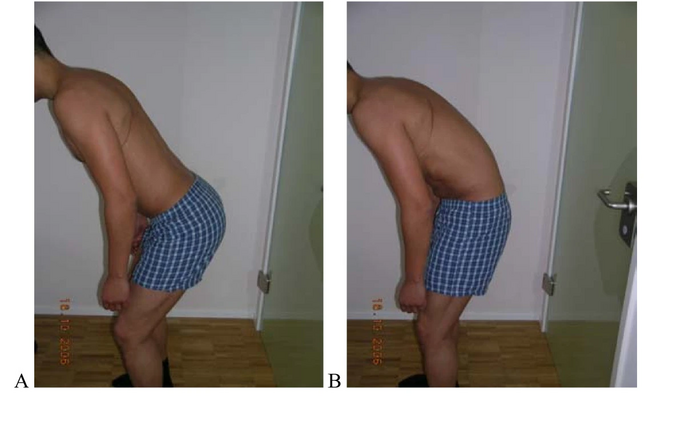
2. Sitting Knee Extension:[edit | edit source]
Test protocol: Upright sitting with corrected lumbar lordosis; extension of the knee without movement (flexion) of low back [1]
Correct: Upright sitting with lumbar lordosis; extension of the knee to within 50° of straight without movement of LB.[1]
Incorrect: Low back moving in flexion prior to within 50° of straight. [1]
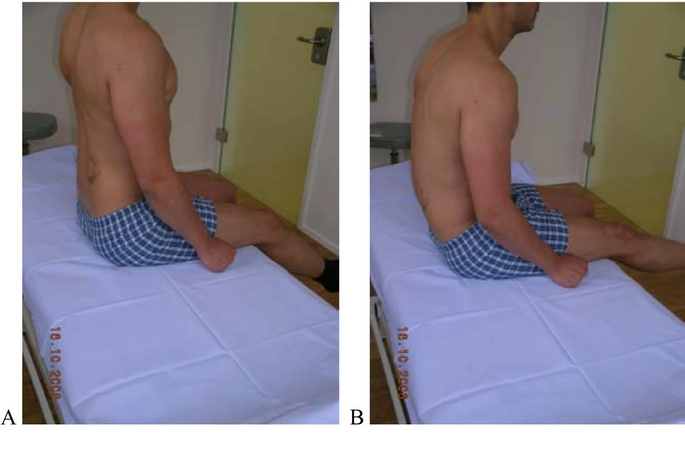
3. Rocking Backwards:[edit | edit source]
Test protocol: Transfer of the pelvis backwards ("rocking") in a quadruped position keeping low back in neutral.[1]
Correct: 120° of hip flexion without movement of the low back by transferring pelvis backwards.[1]
Incorrect: Hip flexion causes flexion in the lumbar spine (typically the patient not aware of this).[1]
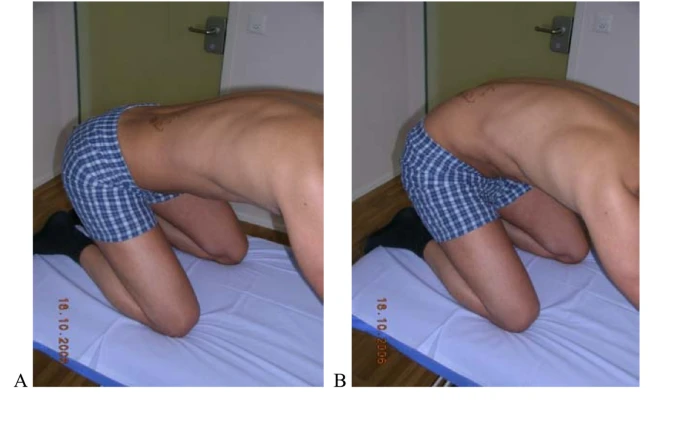
4. Prone Lying Knee Flexion:[edit | edit source]
Test protocol: Actively in prone
Correct: Active knee flexion at least 90° without extension movement of the low back and pelvis.[1]
Incorrect: Low back does not stay neutral, but moves into extension[1]
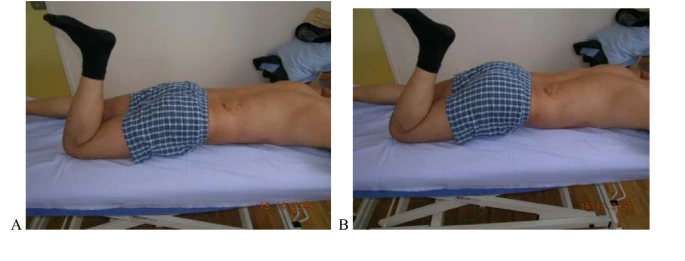
5. Posterior Pelvic Tilt:[edit | edit source]
Test protocol: Actively in upright standing.[1]
Correct: Posterior pelvic tilt the pelvis while in standing by contracting the glute max while keeping the thoracic spine in neutral[1]
Incorrect: Pelvis doesn't tilt or low back moves towards Ext./No gluteal activity/compensatory flexion in thoracic spine[1]
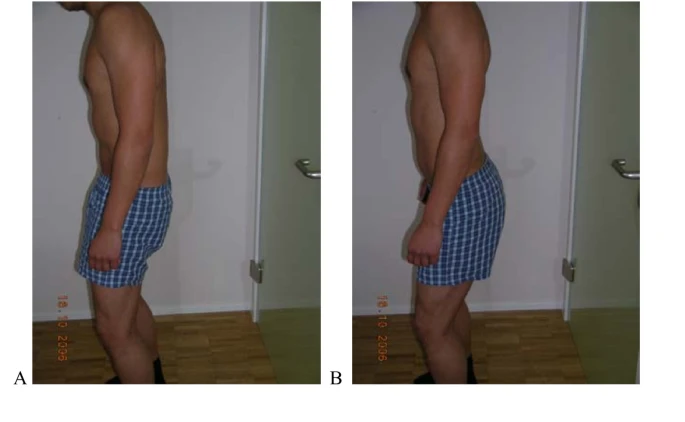
6. Single-leg Stance:[edit | edit source]
Test protocol: Patient’s feet 12cm apart. Use a 20cm ruler and hold it on a stable object with the middle of the ruler lined up with the patient's umbilicus.[1]
Correct: The patient’s umbilicus has <2cm difference side to side and <10 cm transfer on either foot.[1]
Incorrect: Lateral transfer of belly button >2cm difference side to side or > 10 cm in either direction .[1]
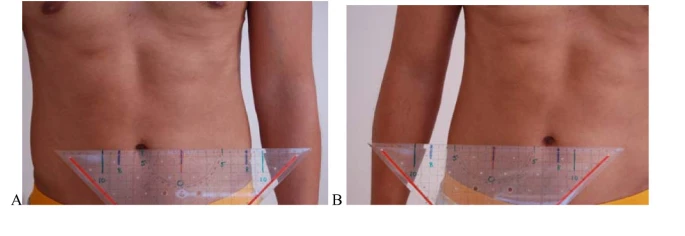
Research Discussion[edit | edit source]
The research by Meier et al[4] evaluated whether there was a difference between people in pain and people without pain. For each positive test on the movement control tests there was an odds ratio of 1.92 more likely to have chronic low back pain.[4]In another study by Khodadad et al[5] Both the cognitive functional treatment and lumbar stabilization treatment improved pain and the movement control tests.[5]The cognitive functional treatment group class sessions involved education, exercise, and relaxation/mindfulness. Stabilization group received cues on how to properly control the spine during the following exercises which were held for 3 seconds:
- Planks
- Bridge
- Bird-dog
- Side bridge
- Curl-up
In an article by Lehtola at al [3], motor control exercises improved disability more than specific exercise at 3 and 12 month follow-up. The motor control exercises were more “specific” instead of general. In the article, pictures are shown of each of the specific and general exercises used but the details of the specific exercises are unclear. The goal was to train movements in different positions and re-educate how to move and control the lumbar spine in relation to the hips and thoracic spine. The general exercises are common core exercises. Both of these groups are very similar to Koumantakis’ article[6] in 2005. The major difference is that in this current research they screened for who psychosocial limiting factors and for those positive on at least 2 of the movement control tests which explains the difference in their results.
References[edit | edit source]
- ↑ 1.00 1.01 1.02 1.03 1.04 1.05 1.06 1.07 1.08 1.09 1.10 1.11 1.12 1.13 1.14 1.15 1.16 1.17 1.18 1.19 1.20 1.21 1.22 1.23 1.24 Luomajoki H, Kool J, De Bruin ED, Airaksinen O. Reliability of movement control tests in the lumbar spine. BMC musculoskeletal disorders. 2007 Dec;8(1):1-1.
- ↑ Alrwaily M, Timko M, Schneider M, Stevans J, Bise C, Hariharan K, Delitto A. Treatment-based classification system for low back pain: revision and update. Physical therapy. 2016 Jul 1;96(7):1057-66.
- ↑ 3.0 3.1 Lehtola V, Luomajoki H, Leinonen V, Gibbons S, Airaksinen O. Sub-classification based specific movement control exercises are superior to general exercise in sub-acute low back pain when both are combined with manual therapy: A randomized controlled trial. BMC musculoskeletal disorders. 2016 Dec;17(1):1-9.
- ↑ 4.0 4.1 4.2 Meier R, Emch C, Gross-Wolf C, Pfeiffer F, Meichtry A, Schmid A, Luomajoki H. Sensorimotor and body perception assessments of nonspecific chronic low back pain: a cross-sectional study. BMC Musculoskeletal Disorders. 2021 Dec;22(1):1-0.
- ↑ 5.0 5.1 Khodadad B, Letafatkar A, Hadadnezhad M, Shojaedin S. Comparing the effectiveness of cognitive functional treatment and lumbar stabilization treatment on pain and movement control in patients with low back pain. Sports Health. 2020 May;12(3):289-95.
- ↑ Koumantakis GA, Watson PJ, Oldham JA. Trunk muscle stabilization training plus general exercise versus general exercise only: randomized controlled trial of patients with recurrent low back pain. Physical therapy. 2005 Mar 1;85(3):209-25.






